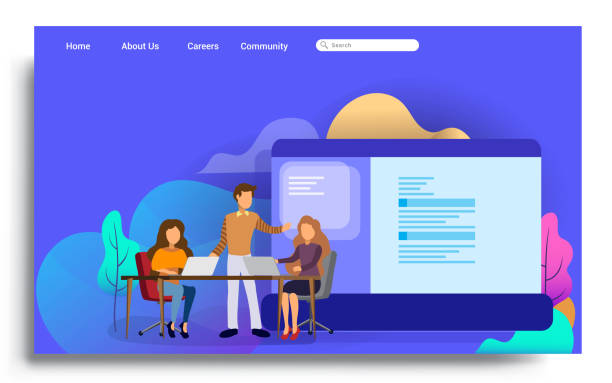Introduction to the Importance of Secure Website Design in the Digital Age

In today’s rapidly digitizing world, websites have become the core of businesses, communications, and information exchange.
With increasing reliance on the online space, the importance of secure website design has become more vital than ever.
Cybersecurity is no longer an option; it’s an undeniable necessity. Every website, from a simple personal blog to large e-commerce platforms and online banking, is exposed to various threats.
These threats include malware attacks, phishing, data theft, hacking, and denial-of-service (DDoS) attacks.
A comprehensive approach to website security not only protects sensitive user and business data but also significantly helps in maintaining credibility and customer trust.
Numerous news reports indicate that security breaches can lead to millions of dollars in losses and irreparable damage to an organization’s reputation.
Therefore, a deep understanding of data protection mechanisms and their correct implementation at every stage of #website_design, #web_development, and #website_maintenance is of paramount importance.
This article will help you become familiar with the principles and best practices of secure website design and secure your website against cyberattacks.
Our goal is to provide explanatory and informative content on this critical topic so that both professionals and ordinary users can benefit from it.
How much does losing business leads due to an unprofessional website cost you? Solve this problem forever with a professional corporate website design by Rasawweb!
✅ Increase credibility and trust of potential customers
✅ Easier attraction of new business leads
⚡ Get free consultation now!
Understanding Common Threats and Vulnerabilities in Websites

Before we can properly secure a website, we must know the enemy.
The web world is full of threats that can penetrate any system.
Among the most common and dangerous vulnerabilities and attacks are SQL Injection, Cross-Site Scripting (XSS), Cross-Site Request Forgery (CSRF), Broken Authentication, and Insecure Direct Object References.
SQL Injection allows an attacker to access or manipulate the database by injecting malicious SQL code. This can lead to the theft, alteration, or even deletion of vital information.
XSS enables an attacker to inject client-side code (such as JavaScript) into web pages, which can steal user information or take control of their browser.
CSRF forces a user to perform actions they did not intend, such as changing a password or transferring funds.
These types of attacks are usually performed using the user’s credentials in active sessions.
Authentication problems are also very common; from weak passwords to improper management of user sessions, which can allow attackers to hijack user accounts.
Insecure Direct Object References occur when a developer provides direct access to internal system objects (such as files, records, or database keys) without proper validation, allowing an attacker to easily access unauthorized data.
An analytical and specialized approach to secure website design requires developers to be fully familiar with these vulnerabilities and to implement necessary preventive measures at every stage of the software development lifecycle.
Ignoring these issues turns the website into an easy target for attackers.
Principles of Secure Coding and Best Practices in Web Development

The backbone of a secure website design is secure coding.
This approach means writing code that is resistant to common vulnerabilities and attacks.
One of the most important principles is strict input validation. Any data received from the user must be carefully checked and sanitized before use or storage.
This includes checking the data type, length, format, and content to prevent the injection of malicious code.
Using Prepared Statements in database communication is the best method to prevent SQL Injection, as it separates user input from the SQL command.
Also, OWASP Top 10 is an essential guide for developers that lists the most common web vulnerabilities and provides solutions to counter them.
Another principle is Output Encoding.
Any data sent from the server to the user’s browser, especially user-generated data, must be properly encoded to prevent XSS attacks.
This means that special characters that can be executed as code (such as < and >) must be converted to their HTML equivalents.
Implementing the Principle of Least Privilege is also vital; meaning that each module, function, or user should only have the minimum level of access required to perform their tasks.
This limits the scope of damage in case a part of the system is compromised.
Developers must continuously update their knowledge in the field of security and use secure frameworks and libraries that have built-in security mechanisms.
These educational and specialized approaches in development provide a solid foundation for any secure website.
Securing Databases in Secure Website Design

Databases are the heart of any website, storing sensitive user information, transactions, and content.
Therefore, securing them is one of the main pillars of secure website design.
The first step is implementing strict access control. Only authorized users and processes should have access to the database, and their access should be configured based on the principle of least privilege.
Strong and unique passwords for database user accounts are essential and should be changed regularly.
Encrypting data, both in transit and at rest, adds a vital layer of protection.
Highly sensitive data such as financial or personal information should be encrypted before being stored in the database.
Using strong hashing functions (like bcrypt or Argon2) along with Salt for storing passwords prevents password exposure in case of a security breach.
Also, regular and secure backups of the database, stored in separate and secure locations, are crucial for data recovery in case of disaster.
Preventing SQL Injection attacks, as mentioned earlier, is essential by using Prepared Statements or ORMs (Object-Relational Mappers) that support parameterized queries.
Also, disabling database features that are not necessary for your website’s normal operation and could create vulnerabilities (such as executing shell commands via the database) is an important measure.
Continuous monitoring of database activities to identify any suspicious behavior is also recommended.
Finally, training the development team on database security best practices is a vital investment.
These guiding and specialized measures help you protect your website’s most important asset.
| Security Measure | Description | Benefit |
|---|---|---|
| Input Validation | Reviewing and sanitizing all user input data | Prevention of SQL Injection and XSS |
| Use of Prepared Statements | Separating code from data in database queries | Primary defense against SQL Injection |
| Data Encryption | Encrypting sensitive information at rest and in transit | Protection of data against unauthorized access |
| Regular Backup | Creating backup copies of the database | Ability to recover information after a disaster |
Research shows that 80% of customers trust companies with a professional website more. Does your current site inspire this trust?
With Rasawweb’s corporate website design services, solve the problem of customer distrust and a weak online image forever!
✅ Create a professional image and increase customer trust
✅ Attract more sales leads and grow your business
⚡ Get free consultation!
Implementing Strong Authentication and Authorization

Authentication and authorization are two main pillars in controlling access to website resources and play a key role in secure website design.
Authentication means verifying a user’s identity (Are you who you claim to be?), while authorization determines what resources the authenticated user has access to and what operations they can perform. Implementing strong authentication includes using complex passwords, weak password detection mechanisms, and requiring periodic password changes.
Also, using multi-factor authentication (MFA) is highly recommended.
MFA, in addition to a password, requires a second factor such as a code sent to a mobile phone or a fingerprint, which significantly increases the security of user accounts.
Secure password storage is another crucial point.
Passwords should never be stored in Plain Text.
Instead, strong, one-way hashing functions like bcrypt or Argon2 should be used along with Salt.
Salt is a random string added to each password before hashing, preventing “Rainbow Table” attacks.
Session Management must also be carefully performed; session IDs should be long, random, and unpredictable, and expire after a specified period or after the user logs out.
Also, any attempt to guess passwords or failed login attempts should be logged, and if necessary, the user account should be locked.
In terms of authorization, role-based access control (RBAC) mechanisms should be used.
This means that users have access to specific resources based on their roles (e.g., administrator, editor, normal user).
Every request from the user must be checked for authorization before processing.
Never rely on client-side security, as attackers can easily bypass it.
All authorization checks must be performed on the server-side.
These educational and specialized approaches significantly enhance your website’s security against unauthorized access.
The Role of Firewalls and Network Security in Website Protection

Beyond secure coding and database security, network security and the use of firewalls provide another layer of protection for the website. A firewall is a network security system that controls incoming and outgoing traffic based on pre-defined security rules.
Firewalls can be hardware or software and play a vital role in filtering malicious traffic and preventing unauthorized access.
A Web Application Firewall (WAF) is specifically designed to protect websites against common web attacks such as SQL Injection and XSS.
WAFs are positioned in front of the web server and inspect HTTP/HTTPS requests before they reach the web application.
They can identify and block malicious traffic patterns, even if a specific vulnerability exists in the website’s code.
In addition to WAFs, implementing a secure network architecture is also very important in secure website design.
This includes Network Segmentation, meaning that different parts of the infrastructure (such as web servers, database servers, and management servers) are placed in separate networks with restricted access.
This prevents an attacker from easily gaining access to the entire system if one part is compromised.
Intrusion Detection Systems (IDS) and Intrusion Prevention Systems (IPS) can also be used to monitor network traffic and identify and block suspicious activities.
IDS/IPS can detect attacks such as port scanning, password guessing attempts, and DDoS attacks.
Proper configuration of servers and operating systems, disabling unnecessary services, and regularly updating all network and server software are also of high importance.
These explanatory and specialized measures, combined with a comprehensive secure website design strategy, protect your website against network-level threats.
The Importance of SSL/TLS Certificates and Communication Encryption

In today’s world, a website that does not use HTTPS is easily considered insecure.
SSL/TLS (Secure Sockets Layer/Transport Layer Security) certificates provide encryption for communications between the user’s browser and the website server. This means that any data transmitted between the user and the website (such as login information, credit card details, or personal messages) is encrypted and hidden from hackers or third parties listening to network traffic.
This is a fundamental component of secure website design and user privacy.
HTTPS not only ensures data security but also has a positive impact on website SEO.
Search engines like Google prefer websites that use HTTPS in their search result rankings.
There are different types of SSL/TLS certificates, including: DV (Domain Validation), OV (Organization Validation), and EV (Extended Validation).
DV certificates are the cheapest and fastest type and only verify domain ownership.
OV and EV include more information about the issuing organization’s identity in the certificate and provide a higher level of trust.
Especially EV SSL, which shows a green bar and the company name in the browser, significantly increases user trust.
Proper installation and configuration of the SSL/TLS certificate on the web server and ensuring that all website content (images, scripts, styles) are loaded via HTTPS (preventing Mixed Content) is very important.
Using HSTS (HTTP Strict Transport Security) is also recommended, which instructs browsers to always access your website via HTTPS, even if the user mistakenly types the HTTP protocol.
These explanatory and guiding measures help you provide a secure communication environment for your users, which is a critical aspect of secure website design.
| SSL Certificate Type | Level of Identity Verification | Common Uses |
|---|---|---|
| Domain Validation (DV) | Only verifies domain ownership | Blogs, personal websites, small sites |
| Organization Validation (OV) | Verifies domain and organization identity | Companies, commercial websites, online stores |
| Extended Validation (EV) | Highest level of organization identity verification | Online banking, large financial organizations, websites requiring highest trust |
Regular Security Audits and Penetration Testing for Security Sustainability

Even the best secure website design will become vulnerable over time without continuous monitoring and testing.
Cyber threats are evolving, and new vulnerabilities are discovered regularly.
For this reason, conducting regular security audits and Penetration Testing is essential to maintain the sustainability of a website’s security.
Security audits involve reviewing code, server configuration, network settings, and security processes to identify weaknesses and flaws.
These audits can be performed by an internal team or external security experts.
The main goal is to find vulnerabilities before attackers discover them.
Penetration testing, sometimes called “ethical hacking,” simulates a real cyberattack conducted by security professionals (known as penetration testers) to identify vulnerabilities that might be overlooked during regular audits. Penetration testers attempt to infiltrate the system through various methods, including social engineering attacks, software vulnerabilities, and misconfigurations.
The results of penetration testing provide a comprehensive report of the vulnerabilities found and recommendations for fixing them.
This analytical and guiding process helps organizations identify their hidden weaknesses and address them before attackers exploit them.
In addition to penetration testing, using automated Web Vulnerability Scanners can also help in quickly and regularly identifying common vulnerabilities.
These tools can automatically scan the website for known issues.
Bug Bounty Programs are also a modern approach where security professionals (bug hunters) receive financial rewards for finding and reporting vulnerabilities in your system.
This method allows organizations to leverage the collective knowledge and experience of the security community to improve their secure website design.
Implementing these preventive and continuous strategies ensures that your website’s security is always up-to-date and resistant to new threats.
Disappointed with your e-commerce site’s low conversion rate? Rasawweb transforms your e-commerce site into a powerful tool for attracting and converting customers!
✅ Significant increase in visitor-to-buyer conversion rate
✅ Unparalleled user experience for increased customer satisfaction and loyalty⚡ Get free consultation from Rasawweb!
User Education and Awareness Against Phishing and Social Engineering Attacks

Although all technical measures for secure website design are vital, the weakest link in any security system is often the human element. Social engineering and phishing attacks, which target users, remain one of the most successful ways for attackers to gain access to systems and information.
A phishing attack is an attempt to trick individuals into revealing sensitive information such as usernames, passwords, or credit card details, by impersonating a trustworthy entity.
These attacks can be conducted via email, SMS, phone calls, or even fake websites.
Therefore, continuous user education and awareness about security threats are essential to complete a comprehensive web security strategy.
Users should be trained on how to identify phishing emails (such as carefully checking sender addresses, suspicious links, and poor grammar).
They must understand the importance of using strong and unique passwords and never using the same password for multiple services.
Also, emphasizing the activation of two-factor authentication (2FA) on all supporting accounts is crucial.
This creates an additional security layer even if passwords are compromised.
Awareness can take various forms: from holding training workshops and briefings to sending informational emails and creating engaging and accessible educational materials (such as infographics or short videos).
Users should be encouraged to report any suspicious activity they observe.
This guiding and engaging approach not only improves website security but also creates a stronger security culture within your organization or user community.
Remember that an informed user is the best line of defense against targeted social engineering attacks.
Future Trends in Secure Website Design and Continuous Updates

The world of cybersecurity is not static, and threats are constantly evolving.
To maintain website security in the future, it is necessary to be familiar with new trends and continuously update our solutions.
One important trend is the use of Artificial Intelligence (AI) and Machine Learning (ML) in cyberattacks.
Attackers use AI to automate and target attacks, such as more sophisticated phishing attacks or identifying vulnerabilities on a large scale.
Conversely, AI and ML are also used in defensive tools to identify unusual patterns, detect advanced threats, and automate responses to security incidents.
Other trends include an increased focus on Software Supply Chain Security; where attackers target open-source libraries and components to inject malware.
Also, security architectures like “Zero Trust” are expanding, which are based on the premise that no user or device, even within the network, should be automatically trusted, and every access must be carefully verified.
Blockchain also offers potential in secure identity and data storage due to its distributed and immutable characteristics, although its widespread application in website security is still in its early stages.
To maintain secure website design against these developments, regular software and system updates are a non-negotiable necessity.
This includes updating the operating system, web server, database, development frameworks, and all plugins and libraries used.
Each update typically includes fixes for known security vulnerabilities.
Continuous monitoring of security reports and participation in specialized security forums are also vital for staying aware of the latest threats and solutions.
The analytical and informative approach in this field helps us keep our websites resilient against the changing threat landscape and protect sensitive information.
Frequently Asked Questions
| Row | Question | Answer |
|---|---|---|
| 1 | What is secure website design? | Secure website design is a process in which websites are built with security measures in mind from the initial stages of development to be protected against cyberattacks, unauthorized access, and data loss. |
| 2 | Why is secure website design important? | Website security is crucial for maintaining user trust, protecting sensitive information (personal and financial), preventing damage to brand reputation, and complying with privacy and security regulations (such as GDPR). Security breaches can lead to financial and legal damages. |
| 3 | What are the most common cyberattacks a website faces? | Some of the most common attacks include SQL Injection, Cross-Site Scripting (XSS), Distributed Denial of Service (DDoS), Brute Force, and authentication-based attacks (Credential Stuffing). |
| 4 | What is SQL Injection and how to prevent it? | SQL Injection is an attack type where an attacker tries to manipulate the database or extract information by injecting malicious SQL code into site inputs. To prevent it, you should use Prepared Statements/Parameterized Queries, ORM (Object-Relational Mapping), and strict input validation. |
| 5 | What is Cross-Site Scripting (XSS)? | XSS is an attack type where an attacker injects malicious scripts (usually JavaScript) into web pages that are executed by other users’ browsers. This can lead to cookie theft, session information theft, or alteration of the website’s appearance. |
| 6 | How can Brute Force attacks on login pages be prevented? | To prevent Brute Force, you should use CAPTCHA, limit the number of failed login attempts (Account Lockout), two-factor authentication (2FA), and use complex and long passwords. |
| 7 | What is the role of HTTPS in website security? | HTTPS encrypts the communication between the user’s browser and the website server using SSL/TLS. This prevents eavesdropping, tampering, or spoofing of information during transmission and increases user trust. |
| 8 | What is the importance of Input Validation in security? | Input validation is the process of checking and sanitizing data entered by the user. This prevents malicious code injection, XSS attacks, SQL Injection, and other vulnerabilities, ensuring that the data conforms to the expected format. |
| 9 | Why is regular updating of website systems and software necessary? | Regular updating of the operating system, CMS (like WordPress), plugins, themes, and libraries used fixes known security vulnerabilities. Hackers often exploit weaknesses in outdated software to infiltrate. |
| 10 | What is the role of regular backups in secure website design? | Regular and tested backups of website data (database and files) provide a crucial layer of defense against data loss due to cyberattacks, human error, or hardware failure. This enables quick website recovery in case of a disaster. |
And other services of Rasaweb Advertising Agency in the field of advertising
Smart Google Ads: Professional optimization to improve SEO ranking using Google Ad management.
Smart UI/UX: Professional solution for user interaction focusing on optimizing key pages.
Smart Digital Advertising: Fast and effective solution for online growth focusing on custom programming.
Smart Sales Automation: Fast and effective solution for analyzing customer behavior focusing on precise audience targeting.
Smart Website Development: A combination of creativity and technology for analyzing customer behavior by optimizing key pages.
And over hundreds of other services in the field of internet advertising, advertising consultation, and organizational solutions
Internet Advertising | Advertising Strategy | Advertorials
Resources
Secure Website Design Guide
Website Security Principles
Secure Coding Practices
Website Cybersecurity Solutions
? Are you ready to grow your business in the digital world? With Rasawweb Afarin Digital Marketing Agency’s comprehensive services, including e-commerce website design and SEO optimization, establish a powerful online presence.
📍 Tehran, Mirdamad Street, next to Central Bank, Kazeroon Jonoubi Alley, Ramin Alley, No. 6




